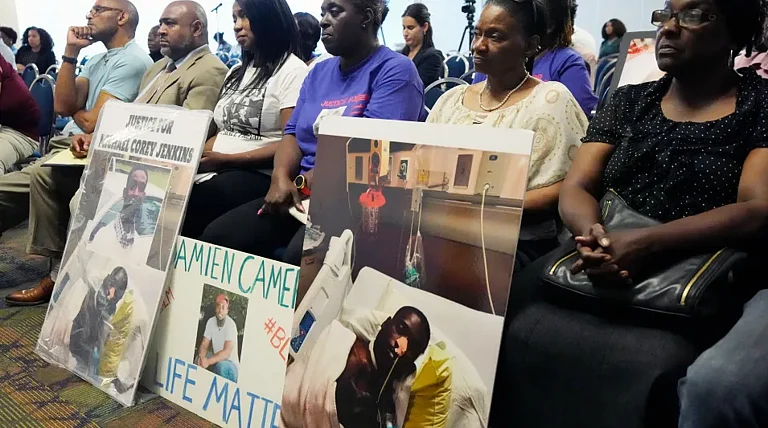An Ohio man who was restrained with handcuffs and left lying facedown on the floor of a social club last week died while in police custody. The officers involved in the incident have been placed on paid administrative leave.
According to police body-camera footage released on Wednesday, a Canton police officer responded to a report of a crash and discovered Frank Tyson, a 53-year-old East Canton resident, near the bar at a local American Veterans, or AMVETS, post.
The crash, which occurred around 8 p.m. on April 18, had caused damage to a utility pole. Officer Beau Schoenegge's body-camera footage shows that upon arriving at the scene, a woman opened the door and urgently requested, "Please get him out of here, now."
Tyson was apprehended by the police, and although he resisted being handcuffed, he repeatedly exclaimed, "They're trying to kill me" and "Call the sheriff" as he was brought to the floor.
While being restrained, including with a knee on his back, Tyson immediately expressed difficulty breathing to the officers. This tragic incident echoes findings from a recent Associated Press investigation, which highlighted cases where similar pleas for help, such as "I can't breathe," were disregarded in other instances of deaths in police custody.
While Tyson was lying facedown with his legs crossed on the carpeted floor, officers reassured him that he was fine and urged him to calm down and stop resisting. Meanwhile, they engaged in casual conversation with bystanders and casually examined Tyson's wallet, unaware of the medical emergency unfolding.
Approximately five minutes after Tyson's repeated plea of "I can't breathe" was captured on body-camera footage, one officer asked another if Tyson had settled down. The response indicated concern that Tyson might have lost consciousness.
The distressing situation, wherein Tyson expressed difficulty breathing, draws parallels to the events leading up to the death of George Floyd at the hands of Minneapolis police in 2020. According to the coroner's office, Tyson was Black. Both officers from the Canton Police Department traffic bureau who were placed on leave, Schoenegge and Camden Burch, are white, as confirmed by the police department.
When an officer instructed Tyson to stand and attempted to roll him over, Tyson remained motionless. Officers then shook him and checked for a pulse.
Minutes later, an officer expressed urgency for medics to "step it up" as Tyson showed no response, and there was uncertainty about his pulse. CPR was initiated by the officers.
According to the Canton police report released on Friday regarding Tyson's death, officers acknowledged Tyson's unresponsiveness shortly after securing him, leading to the initiation of CPR. Before the arrival of medics, doses of Narcan were administered. Tyson was pronounced dead at a hospital less than an hour later.
Chief investigator Harry Campbell from the Stark County Coroner's Office stated that an autopsy had been conducted earlier in the week, and Tyson's remains were subsequently released to a funeral home.
In an interview with WEWS-TV in Cleveland, Tyson's niece, Jasmine Tyson, criticized the video, describing it as "nonsense" and expressing frustration at the delay in checking on her uncle.
Frank Tyson had been released from state prison on April 6 after serving 24 years for a kidnapping and theft case. He was promptly declared a post-release control supervision violator for failing to report to a parole officer, according to the Ohio Department of Rehabilitation and Correction.
A Tyson family member contacted by phone on Thursday declined to provide immediate comment.
The Ohio Attorney General's Bureau of Criminal Investigation announced in a statement on Thursday that its investigation will not determine the justification of force used, leaving the decision on potential charges related to the use of force to the prosecuting attorney or a grand jury.
Canton Mayor William V. Sherer II stated that he extended his condolences to Frank Tyson's family in person. In a statement released on Wednesday, Sherer stated, “as we make it through this challenging time, my goal is to be as transparent with the community as possible.”
Since the mid-1990s, the U.S. Department of Justice has cautioned police officers about the danger of positional asphyxia, advising them to roll suspects off their stomachs promptly after handcuffing them. While many policing experts acknowledge the risk of someone ceasing to breathe if pinned on their chest for too long or with excessive weight, putting someone on their stomach is not inherently life-threatening when done correctly.
A March investigation conducted by The Associated Press revealed that over a decade, more than 1,000 individuals died after being subdued by police using methods not intended to be lethal, including prone restraint.





























